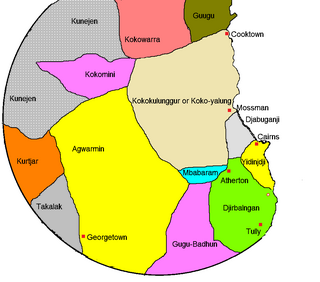Related Research Articles
The Wilson River language, also known as "Modern" Wankumara, is an Australian Aboriginal language of the Karnic family. It was spoken by several peoples along the Wilson River in Queensland. Of these, the Wanggumara (Wangkumara) and Galali may have migrated from the Bulloo River and abandoned their language when they arrived.
Yalarnnga is an extinct Australian Aboriginal language of the Pama–Nyungan language family, that may be related to the Kalkatungu language. It was formerly spoken by the Yalarnnga people in areas near the Gulf of Carpentaria the towns of Dajarra and Cloncurry in far northwestern Queensland. The last native speaker died in 1980. It is a suffixing agglutinative language with no attested prefixes.
Kalkatungu is an extinct Australian Aboriginal language formerly spoken around the area of Mount Isa and Cloncurry, Queensland.
Ngawun is an extinct Mayi language once spoken on the Cape York Peninsula of Queensland, Australia, by the Wunumara and Ngawun peoples. The last speaker of the language was Cherry O'Keefe who died of pneumonia on 24 August 1977.

The Karnic languages are a group of languages of the Pama–Nyungan family. According to Dixon (2002), these are three separate families, but Bowern (2001) establishes regular paradigmatic connections among many of the languages, demonstrating them as a genealogical group. Bowern classifies them as follows:

Maran or Maric is an extinct branch of the Pama–Nyungan family of Australian languages formerly spoken throughout much of Queensland by many of the Murri peoples. The well attested Maric languages are clearly related; however, many languages of the area became extinct before much could be documented of them, and their classification is uncertain. The clear Maric languages are:
Wagaya (Wakaya) is an extinct Australian Aboriginal language of Queensland. Yindjilandji (Indjilandji) may have been a separate language. The linguist Gavan Breen recorded two dialects of the language, an Eastern and a Western variety, incorporating their description in his 1974 grammar.
Wanggamala, also spelt Wanggamanha, Wangkamahdla, Wangkamadla, Wangkamanha, Wangkamana, Wonkamala, Wongkamala, Wonkamudla, and other variants, is an extinct Australian Aboriginal language of the Pama–Nyungan family, previously spoken in the Northern Territory around Hay River and to the south of the Andegerebinha-speaking area.
Yandruwandha is an Australian Aboriginal language of the Pama–Nyungan family. Yawarawarga is considered a dialect by Dixon (2002), a closely related language by Bowern (2001). It is also known as Yawarrawarrka,Yawarawarka, Yawarawarga, Yawarawarka, Jauraworka, and Jawarawarka).
Biri, also known as Biria, Birri Gubba, Birigaba, Wiri, Perembba and other variants, is an Australian Aboriginal language of the Mackay area of Queensland spoken by the Birri Gubba people. There are at least eight languages regarded as dialects of Biri, and two which are related but whose status is not yet fully determined. All are covered in this article.

Wamin, also known as Agwamin or Ewamian, is an Australian Aboriginal language of North Queensland spoken by the Ewamian people. Wamin was traditionally spoken in the Etheridge region, in the areas around Einasliegh, Georgetown, and Mount Surprise.
Mithaka is an extinct Australian Aboriginal language in the Barcoo Shire of Western Queensland spoken by the Mitaka people.
Badjiri is an extinct Aboriginal Australian language once spoken by the Badjiri people of southern Queensland.
Waanyi, also spelt Wanyi, Wanji or Waanji, is an endangered Australian Aboriginal language spoken by the Waanyi people of the lower gulf area of Northern Queensland, Australia. Although earlier thought to be extinct, as of the 2016 Australian census there were 16 speakers of the language. This was down from the recorded peak of 40 in the 2011 Australian census.
Guwa, also spelt Goa, Koa, and other variants, is an extinct and nearly unattested Australian Aboriginal language of Queensland spoken by the Koa people. It was apparently close to Yanda.
Bindal is an extinct Australian Aboriginal language of North Queensland. The Bindal language region included the area from Cape Cleveland extending south towards Ayr and the mouth of the Burdekin River, encompassing the landscape within the boundaries of the Townsville City Council and Burdekin Shire Council.
Kungkari is an extinct and unclassified Australian Aboriginal language. The Kungkari language region included the landscape within the local government boundaries of the Longreach Shire Council and Blackall-Tambo Shire Council.
Gavan Breen, also known as J. G. Breen, was an Australian linguist, specialising in the description of Australian Aboriginal languages. He studied and recorded 49 such languages.
The Bidia, also called Biria, are an Aboriginal Australian people of the central west and western regions of the state of Queensland. Their language is known as Pirriya.
The Yalarnnga, also known as the Jalanga, are an Indigenous Australian people of the state of Queensland.
References
- 1 2 L36 Pirriya at the Australian Indigenous Languages Database, Australian Institute of Aboriginal and Torres Strait Islander Studies
- ↑
 This Wikipedia article incorporates text from Pirriya published by the State Library of Queensland under CC BY licence , accessed on 30 May 2022.
This Wikipedia article incorporates text from Pirriya published by the State Library of Queensland under CC BY licence , accessed on 30 May 2022. - 1 2
 This Wikipedia article incorporates text from Birria published by the State Library of Queensland under CC BY licence , accessed on 30 May 2022.
This Wikipedia article incorporates text from Birria published by the State Library of Queensland under CC BY licence , accessed on 30 May 2022. - ↑ Bowern, Claire (2001). "Karnic classification revisited". In J Simpson; et al. (eds.). Forty years on. Canberra Pacific Linguistics. pp. 245–260. Archived from the original on 3 November 2021.
- ↑ Dixon, R. M. W. (2002). Australian Languages: their nature and development. Cambridge University Press.
- ↑ Breen, Gavan (1990). Salvage studies of Western Queensland Aboriginal languages (PDF). Pacific Linguistics B-105. Canberra: Pacific Linguistics.
- ↑ Blake, Barry J.; Breen, Gavan (1990). Pirriya. In Gavan Breen (ed.), Salvage studies of Western Queensland Aboriginal languages: Canberra: Research School of Pacific and Asian Studies, Australian National University. pp. 6–21.